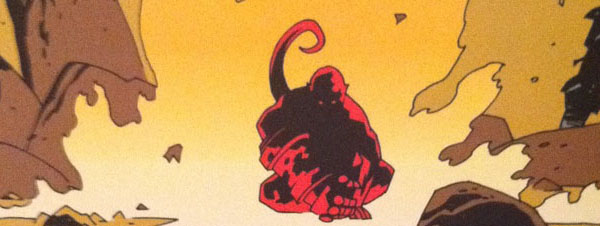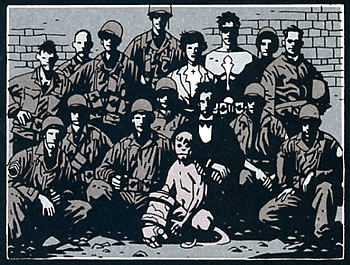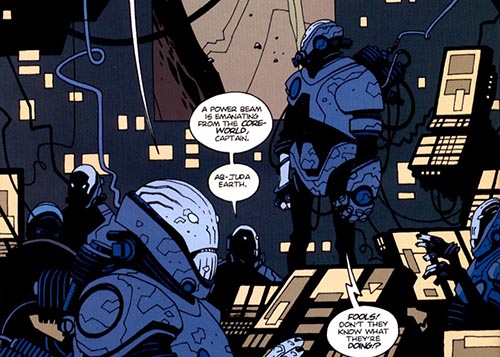
The Great Hellboy Re-Reading Project Part I: Seed of Destruction
I was a fan of Mike Mignola’s Marvel and DC work when, in 1994, he launched a new creator-owned comic for Dark Horse Comics with the four-issue mini-series Hellboy: Seed of Destruction. I’m not sure what drove me to pick up that first issue. Likely it was my previous enjoyment of Mr. Mignola’s mainstream super-hero work. It probably also didn’t hurt that Hellboy’s actual first appearance wasn’t in Seed of Destruction #1, but in a cameo in John Byrne’s Next Men #21. I was a monstrous fan of Mr. Byrne’s magnificent Next Men series, and that might have been what sealed the deal for me with regards to Hellboy.
I enjoyed the first mini-series, and eagerly followed Hellboy for many years that followed. Mr. Mignola released about one mini-series a year, plus a variety of short stories and a few spin-offs. After about a decade, Mr. Mignola’s productivity began to decrease (at least in terms of actual comic books published — he was still involved in a variety of projects) and new Hellboy stories became fewer and father between. Around 2004 was an important turning point for the series. Mr. Mignola brought in a small group of writers and artists to assist with some spin-off titles, most notably a series of B.P.R.D. mini-series (exploring the supporting cast at the Bureau for Paranormal Research and Defense) and, eventually, to draw the main Hellboy mini-series. At first I was extremely worried, and not at all eager to see these other writers and artists dilute the quality of the Hellboy stories. But something magical happened. Bringing in these talented collaborators allowed Hellboy to flourish, and what had been a sporadic series of mini-series grew to become a whole line of books (albeit one that, thank goodness, has remained small and tightly-knit, avoiding the common mistake that comic-book companies and creators make of overexposing their characters and diluting what had once been a special, unique product).
Today, twenty years into the Hellboy saga, there are often two-to-four Hellboy-related books published every month, and they are all amazing. Over the years, Mr. Mignola and his team have published a wealth of mini-series focusing on many different characters and corners of the Hellboy universe. Mr. Mignola and his collaborators have created an extraordinary fantasy universe, and because we don’t have to wait for Mr. Mignola too write and draw every single thing himself, we’ve been treated to lots of different stories that have explored numerous facets of this universe and its characters, their past and present. Mr. Mignola has kept a very close handle on things and has been centrally involved with all of the new comics, giving the many different mini-series an impressively cohesive feel. I love long-form story-telling, and Hellboy is one of the finest examples of this in comic-books today. The Hellboy universe is complex, but phenomenally well thought-out and consistent in terms of its continuity. This is a series that rewards attentive readers, and Mr. Mignola and his team seem to delight in playing the “long game” — sliding in a reference to a character in one issue, then waiting a decade or so (I’m not kidding) to give us a sequence or perhaps even a whole mini-series to explore that character and to give context and resonance to what had seemed like an unimportant, throw-away scene or line of dialogue from so many years before.
Any time I go back and re-read earlier issues, I am always astounded by the amazing connections I find, the things I’d never noticed before, the way a later story casts an earlier one into an entirely new light. But it’s been a few years since I have had the time to go back and re-read the earlier Hellboy stories. I have been itching for a re-read for a while now, and finally the time has come. Not one to do things by half, I have decided to go back to the very beginning, 1994’s Seed of Destruction #1, to re-read the entire Hellboy saga from start-to-finish. (Well, not to “finish” exactly, since the story is still ongoing. I guess I should say from start-to-present-day.)
I have already begun, and though I have quite a ways yet to go, this has already been a hugely enjoyable and rewarding experience. I have been staggered by how many amazing connections and little details I have discovered, even in those early comics that I have read many times before. I can’t wait to tell you all about it.
For years now, the Hellboy line of books has topped my Best Comic-Books of the Year lists, and with good reason. Time to discover why! Let’s dive in, shall we?
Seed of Destruction (1994) — This four-issue mini-series is the very first Hellboy mini-series. Though Mr. Mignola would go on to write and draw this series for years, here in this first installment I guess Mr. Mignola wasn’t quite confident in his abilities, so he had John Byrne on board to write the script. Mr. Byrne is a comic-book master, and he does fine work here, though his script gives Seed of Destruction a slightly different tone than future Hellboy installments would have. Mr. Byrne’s work is more verbose that Mr. Mignola’s more spare style. It works just fine here in Seed of Destruction, but I am glad that Mr. Mignola would quickly take the full reins of his creation. (This is something predicted accurately by Mr. Byrne in his short “afterward” to the first issue! He bet that Mr. Mignola would be writing Hellboy all on his own after only four issues, and he was exactly correct.)
The first issue opens with a prologue set in 1944, and we see the evil Rasputin and the Nazi scientists of Project Ragna Rok summon something from the ether… a little demon boy with a huge stone right hand. Hellboy! It’s a concise and intriguing introduction to the character who we will then meet, fully grown, on page 10, and who we will follow as the lead character throughout this mini-series and the many mini-series to follow. The power of Mike Mignola’s mastery of iconography and his precise use of deceptively simple forms and solid blacks is on full display here in these first few pages. We get a series of incredibly memorable images: Rasputin, cloaked mostly in black, with the Ragna Rok symbol on his chest and the gloriously weird, retro-futuristic sci-fi gauntlets on his hands. The image of the young Hellboy, a blot of red crouching in a field of yellow and orange fire. And, of course, the great gray-toned photograph of Hellboy and Professor Bruttenholm amongst the unit of U.S. Army men who rescued him. It’s interesting to see the Torch of Liberty included in these WWII flashbacks. The Torch was a John Byrne creation. In the mid-nineties Mr. Byrne and Mr. Mignola were part of a small group of writers and artists who had created the “Legend” label at Dark Horse Comics. This wasn’t so much a shared universe as just a group of comic book masters, but there was the occasional bit of cross-pollination in their books. Art Adams’ characters Monkeyman and O’Brien appeared as a back-up feature in this first Hellboy mini-series, and John Byrne’s WWII character the Torch of Liberty (a Captain America-like figure) appeared briefly here in the actual Hellboy story. Legend dissolved soon after and I don’t believe the Torch has been ever again referenced in future Hellboy stories.
Then we meet adult Hellboy and Professor Bruttenholm (pronounced “Broom”), set in present day. (One thing I have loved about the Hellboy universe is that its characters have aged along with the publication history of the various mini-series. So, while it’s not specifically stated here, references in later mini-series inform us that the events of Seed of Destruction took place in 1994, the year of the book’s publication.) It seems that Professor Bruttenholm participated in an ill-fated expedition that uncovered something terrible in the arctic wastelands at the top of the world. The Professor is killed by some sort of frog-man right in front of Hellboy’s eyes, and the weird mystery of the Cavendish family begins to unfold.
Looking back on this now, it seems surprising not only that Mr. Mignola would choose to kill off Professor Bruttenholm right at the beginning of the series, but also that the intelligent, noble Bruttenholm would be so foolish as to participate in the Cavendish expedition. We’ll learn quickly that there was a dark secret in the Cavendish family, and the thing they awoke up in the Arctic was an ancient and terrifying evil, a taste of an ancient threat whose shadow still looms over the Hellboy universes two decades later. It seems out of character for the Bruttenholm who we would later get to know (in a series of future short-stories and mini-series set prior to 1994) to be so stupid as to involve himself with these evil men. I thought little of the death of Bruttenholm at the time. It seemed a logical place for the “hero’s journey” to begin, with the death of his mentor and father-figure. But as the years went by I started to wonder, particularly after seeing what a great character Bruttenholm proved to be in Guillermo del Toro’s first Hellboy film, whether killing him off at the beginning was a mistake. (Bruttenholm met an untimely end in that film as well, but only after we’d gotten to spend a lot of time with him and seen, assisted by William Hurt’s wonderful performance, what a fascinating character he was.) I wonder if Mr. Mignola started to feel the same way, because in the decade since that film we’ve started to see a lot more of Bruttenholm in the comics, particularly in a series of flashback B.P.R.D. mini-series set in the years following World War II, as well as in a variety of other flashbacks and short-stories set before his death in ’94.
Once we get past the prologue of Hellboy’s origin and then the death of Bruttenholm and get into the actual adventure, Seed of Destruction reveals itself to be a terrific yarn and one that, looking back on it, is a classic sort of Hellboy tale. It’s impressive just how right this initial adventure feels, even reading it twenty years later. Yes Mr. Mignola’s art style is a little different, and yes Mr. Byrne’s scripting gives the narrative a slightly different style, but Seed of Destruction is a classic Hellboy tale through and through. If there is a Hellboy formula (and one of the reasons the Hellboy universe of comics has stayed so fresh is that they have never sunk into repetitive formula), then all the classic elements are here: Hellboy and his team (and it’s great that Abe and Liz are here right from the beginning) head to a very weird, creepy place (in this case, Cavendish Hall, the gothic mansion slowly sinking into the swamp around it) to investigate a weird phenomena (the frogs and frog-men who seem to have caused the deaths of Professor Bruttenholm and others) and encounter a much wider level of weirdness and danger (the cursed Cavendish clan; Rasputin himself; and the threat of unleashing the Ogdru Jahad, the imprisoned beasts with the power to destroy the world).
It’s a classic staple of this sort of story that the character’s origin is revealed through the adventure, and the return of Rasputin and what Hellboy learns from him regarding his origins is great. I love the mythology that Mr. Mignola starts developing, right here from the beginning (explored in a great series of flashbacks narrated by Rasputin in issue #3 in which we learn of the Ogdru Jahad, the seven beasts imprisoned somewhere in space, and the Sadu-Hem, left by the Ogdru Jahad to give them a foothold on Earth at all times). Later Hellboy tales will, quite wonderfully, incorporate all sorts of mythology from all over the world. But here in Seed of Destruction, there’s an appealing Nazis-meets-Lovecraft horror background that hits all the right marks. I mention Lovecraft, and this mythology certainly feels very inspired by Lovecraft, but also right from the beginning quite unique in its own right. Mr. Mignola is building up a world of creatures, and their hierarchy in the universe (and, later, he will begin developing a very specific pre-history of his universe) that is complex but never too hard to follow. It feels rich and unique and suitably terrifying in all the right combinations. Even here at the beginning, when one could forgive Mr. Mignola had his ideas not been fully fleshed out, I don’t feel Mr. Mignola leaned too heavily on the work of others (including Lovecraft). Rather, he began charting his own course for the mythology of these characters and this universe. This will pay off in spades down the road.
So will many other plot threads begin here in Seed of Destruction! This four-part mini-series certainly stands on its own as a complete tale, but one of the great delights of this re-read project is seeing just how important this story would turn out to be, and how many little moments and references here will have powerful ripple effects down the road in the Hellboy universe. As Rasputin vows, we haven’t seen the last of him. Abe’s being impaled by Elihu Cavendish will be a moment often-referenced in the years to come. (I still wonder, twenty years later, at Abe’s ability to heal from some grievous wounds). And, though it’s easy to forget about them, two Cavendish brothers/frog-men escape from the destruction, thus setting in motion the Plague of Frogs a decade later that is still reverberating through the Hellboy universe.
But for me, the most intriguing page to re-read was one I had entirely forgotten about: issue #4 page 8, in which we see some sort of alien space station, apparently tasked with monitoring the imprisoned Ogdru Jahad. Hellboy will be, for twenty years, a series jam-packed with fantasy and mysticism. We’ll see ghosts and zombies and vampires and all sorts of demons and other creatures. But, very subtly, the series also has a tiny sliver of sci-fi in it as well. It’s easy to forget, but from what I can tell, the Ogdru Jahad aren’t imprisoned in some other dimension, but deep in outer space. And a few times (only a very few times in twenty years) we have seen a type of alien — as in, an extra-terrestrial. I had totally forgotten that they first appeared all the way back here in Seed of Destruction. Wow. This is still one corner of the Hellboy universe that remains mostly unexplored. I hope that some-day we find out more about these intriguing aliens.
I have lots more to say about Hellboy, but I think that’s enough for now. I’ll be back soon with my thoughts on the next several Hellboy tales, including The Wolves of Saint August and Wake the Devil. See you then!
The issues discussed in this post are collected in: Hellboy vol. 1: Seed of Destruction.


